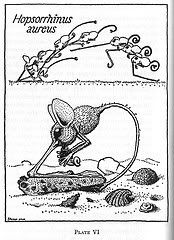 |
The image shows the Nasobema lyricum, aka
"Snouter" the from the folklore section of the Haus der Natur
(House of Nature), a natural history collection in
Salzburg, Austria, uploaded by Curious Expeditions |
The hole in my web-browsing-life left by the disappearance of the Proceedings of the
Anathasius Kircher Society has been partially filled by the discovery [via
the Storque's News of the Craft and Style Blogosphere] of
The Curious Expeditions. Ironically, the upper photo has been in my flickr faves for months, but I never had the sense to check out the profile of the photographer.
The authors of the blog write, "We, your humble explorers, are devoted to unearthing and documenting the wondrous, the macabre and the obscure from around the globe...We are D and M, a gentleman and a gentle lady who were living normal lives, decided to give it all up, and ride narwhals into the sunset." Further, they have documented the
rhinogradentia (as illustrated). I was introduced to the rhinogrades (or "snouters") through Harald Stümpke,
Anatomie Et Biologie Des Rhinogrades — Un Nouvel Ordre De Mammifères. Masson, France (1962), which I picked up in Dijon, about five years ago. The text, for readers of French, can be
found in its entirety, complete with illustrations, online.
The book is one of my favorites, and I am obsessed with books. Never before or since have I read a work of non-science-fiction (or rather non fiction science fiction, perhaps?) of such brilliance. I honestly cried at the end. Stümpke documents an entire mammalian order whose most remarkable characteristic was the nasorium, an organ derived from the ancestral species's nose, which had variously evolved to fulfill every conceivable function, notably including locomotion. Since the order evolved in isolation on the south Pacific Hi-yi-yi islands, it naturally developed its remarkable variety. All the 14 families and 189 known rhinogradentia descended from a small shrew-like animal. They gradually evolved and diversified to fill most of the ecological niches in the archipelago — from tiny worm-like beings to large herbivores and predators. Images can be found
here. Sadly, the entire order, and their home are no more... as the island chain sank into the ocean as a result of an earthquake triggered by the testing of atomic bombs.
 |
{The photo shows the Otopteryx volitans,
the from the folklore section of the Haus der Natur (House of Nature),
a natural history collection in Salzburg, Austria,
uploaded by Curious Expeditions} |
I am comforted by the existence of taxidermied rhinogrades in the wunderkammer of Europe.
See also some more recent scholarship
here,
here and
here.







No comments:
Post a Comment